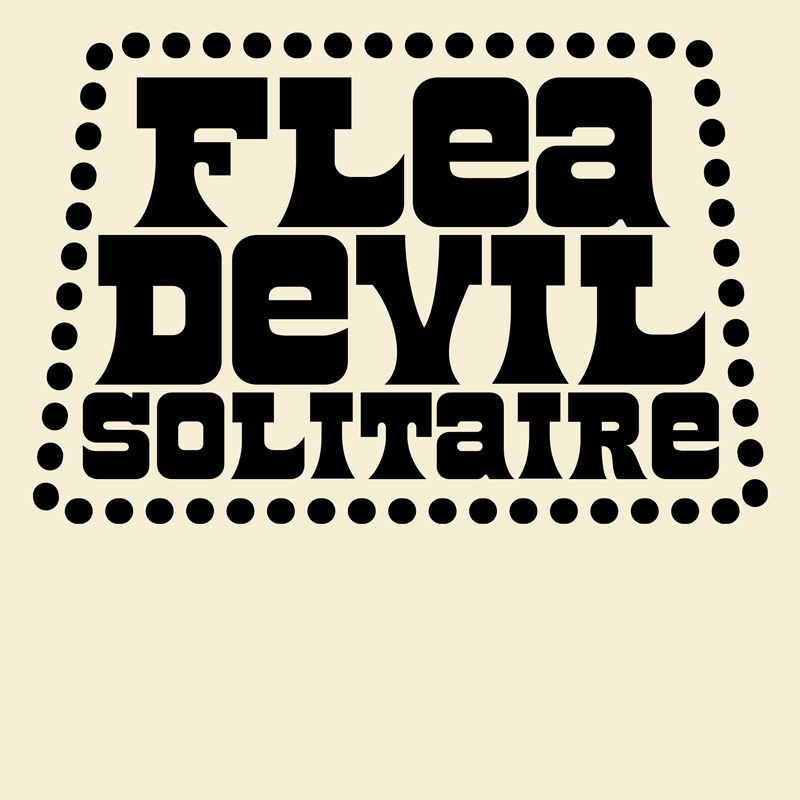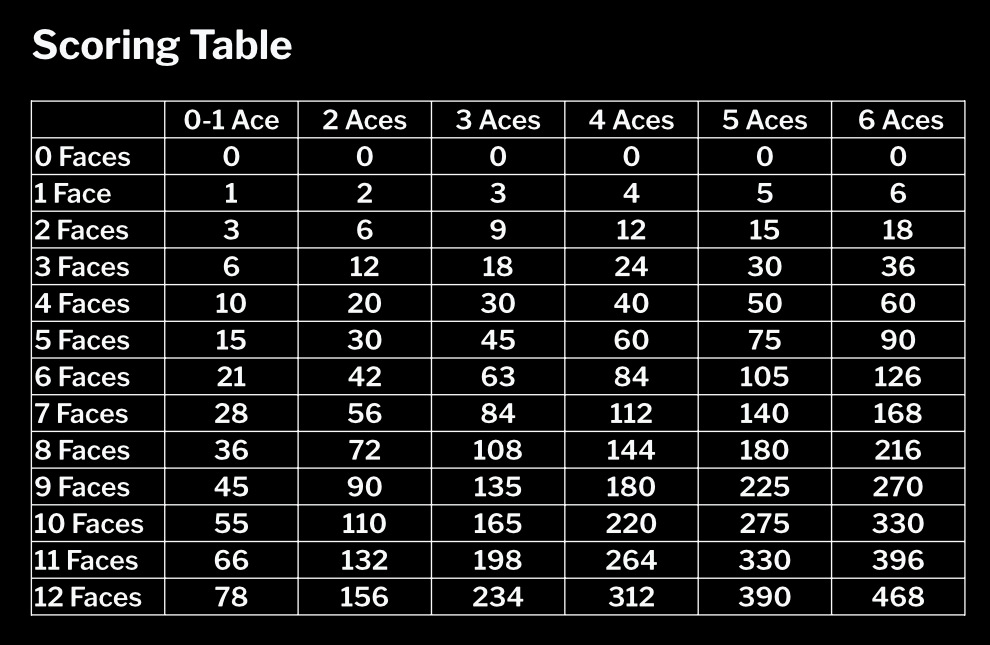Flea Devil Solitaire Rules

I wanted to make the rules of Flea Devil Solitaire more accessible, so I’m making this post. I do think that a video demonstrating the game would be more effective in teaching the game, and I may do that in the future. For now, here are the rules:
=========== ===================
Introduction
=========== ===================
Flea Devil Solitaire is a unique card game invented by Frank Edward Nora over the course of 16 years (2007-2023). From its origin as “Shufflin’ Jamboreee”, to its slow development over the years, to the flurry of activity in 2022 which led to its penultimate form, to the summer 2023 breakthroughs, every step can be heard on Frank’s show, The Overnightscape.
This game is a companion to Onsug Radio, and can be played while listening.
Flea Devil Solitaire is unique in that you hold the deck in your hands at all times – there is no need to place cards on a flat surface at any time. It also can be paused at any time. It’s a pocket game system and natural digital detox.
The theme of the game is buying and selling items at a flea market. That’s where the name comes from – “Flea Devil” is a made-up term for someone who is very good at buying and selling things at a flea market.
Being so different from other games, Flea Devil Solitaire can take some time to learn. But once you know it, the deck of cards you’ve always had will become your best friend. It’s a whole new leisure pursuit!
These are the rules as of late August 2023. The game is still in development, and a few things may change as playtesting continues. (One thing I am looking at is, if the current rules make winning too easy, to add Parking Lots to the card types a Flea Hop cannot land next to, but this remains to be explored).
License for these game rules: Creative Commons Attribution-NonCommercial-NoDerivatives 4.0 International (CC BY-NC-ND 4.0) (https://creativecommons.org/licenses/by-nc-nd/4.0/). Attribution: by Frank Edward Nora – more info at onsug.com
=========== ===================
Overview
=========== ===================
A Flea Devil Solitaire game is played over a number of rounds. Each round can end in a win, with a score, or a loss, which counts as a strike. Keep playing rounds till you reach your third strike, which ends the game. Then add up your score.
=========== ===================
Equipment
=========== ===================
Flea Devil Solitaire game uses a 52-card deck – a standard 52-card deck of playing cards, plus two Zonkers (jokers) and two Parking Lots (the other 2 cards that come in most decks). You’ll also need a way to keep score – paper or digital.
=========== ===================
Zonkers
=========== ===================
Zonkers represent weirdos hanging out at the flea market. They are represented by jokers. Unlike jokers – Zonkers are not wild – they just get in the way, and prevent Flea Hops. They have no suit or rank.
Whenever the two Zonkers are adjacent, you can Zonk Out and send one of them face down to the Easy Go, for free. Also, if a Zonker is adjacent to a Parking Lot, you can Zonk Out for free.
=========== ===================
Parking Lots
=========== ===================
Parking Lots are represented by the two additional cards that come with most playing card decks. Ideally, they should have the same cardback as the rest of the cards – as is the case in some higher-end decks. But it will work no matter what is on the extra cards.
After shuffling, the first move of the round is to choose one of the two Parking Lots and move it to the bottom of the deck – to make a dividing line between the Market and the Easy Go (see more details below).
As mentioned above, any time a Zonker is adjacent to a Parking Lot, it can be Zonked Out for free.
Also, any time two matching cards are on either side of a single Parking Lot, these, and their matches in the market, if any, can be Hauled for free. This is called Hangout. Note that at round start, one of the two Parking Lots must be placed at the bottom of the deck, before gameplay starts – so if both Parking Lots have Hangouts at round start, only one can happen, since the other is moved before any gameplay can happen.
=========== ===================
Areas
=========== ===================
There are 3 areas in the game. The Market is the main face-up set of cards. The Bankroll is the set of face-down cards above the Market, and the Easy Go is the set of face-down and face-up cards below the Market.
=========== ===================
Shuffling
=========== ===================
You can shuffle the deck any way you like, but in keeping with the “table free” nature of the game, shuffling in hand is recommended. I use a combination of overhand and (imperfect) faro shuffles (look them up).
=========== ===================
Jamboree
=========== ===================
When at round start, and you have no Hauls in the Market, and no Flea Hops or Hangouts to make Hauls – meaning you can’t get started at all – you have a Jamboree. This counts as a win, with zero score, and adds one free “strike” to the strike total. Note: Zonk Outs don’t count against a Jamboree.
=========== ===================
Play
=========== ===================
Once the cards are shuffled, turn the deck face-up. This is the Market. You can “Browse” through the Market without limit, while keeping the order unchanged. There are 7 different moves that can be made. Note: all moves are optional, never “forced”.
1 – Haul – when 2 cards of the same rank (like 44 or KK) are adjacent (next to each other) you can remove them from the deck. If they are Stuff (ranks 2 through 10) – place them face down above the market in the Bankroll. Each card in the Bankroll is worth one dollar. If they are Royalties (ranks J-Q-K-A), you can choose to Bank them, just like Stuff, or Score them, by placing them face-up in the Easy Go. Note that when a pair of Royalties is Hauled, you can choose to split them – Banking one and Scoring one. Note that any of these moves cannot be reversed once done.
2 – Bargain – you can swap the position of any two adjacent cards in the Market by paying one dollar. To pay one dollar, move a card from the Bankroll to the Easy Go, keeping it face down.
3 – Flea Hop – move a card one or more spaces for free – this is the essential move in Flea Devil Solitaire! In the Market, find a continuous set of two or more cards of the same suit. The leftmost or rightmost of these cards can jump away from the set – movingone or more spaces, by “pushing off” the rest of the cards in the set. For example, if there are three clubs in a row, a jump of one or two spaces can be made. If there are five clubs in a row, a jump of one to four cards can be made. Once the card “lands” from the hop, it may not be in contact with a card of its same suit, or a Zonker – so check beforehand.
4 – Devil Hop – a “Devil” is a set of four adjecant cards with one of each suit. If there are two or more Devils in the market, you can Devil Hop. Pay three dollars, and move one Devil next to another Devil. This is a big move that can really change things!
5 – Walky Talky – find a run of three cards in the Market, forward or backward (like 3-4-5 or Q-J-10), the middle card can move next to a matching card in the Market, for three dollars. Note that 2-A-K and K-A-2 are allowed. If the moved cards are Stuff (ranks 2 through 10) – you can turn them into an Antique as opposed to Banking them. To do this, place the pair of Stuff cards face-up in the Easy Go. These two cards cannot be split – they must stay together. At round end, an Antique counts as an Ace. Also, an Antique may be used to pay for a single Bargain, by turning both cards face-down in the Easy Go. This is the only case where any change can be made to cards already in the Easy Go.
6 – Zonk Out – if two Zonkers are adjacent in the Market, you can move one of them face-down to the Easy Go. You can also Zonk Out if a Zonker is adjecent to a Parking Lot.
7 – Hangout – if there are two cards of the same rank on either side of a single Parking Lot, you can Haul both, along with their matches, if still in the Market, for free. This is a very powerful move, to potentially Haul four cards for free!
=========== ===================
Snafu
=========== ===================
Mistakes happen in life, and Flea Devil Solitaire is no exception. From dropping cards, to messing up hauls, to shuffling a game in progress, Snafus are going to happen.
If you make an unintentional mistake, and can’t undo it, that’s a Snafu. The round ends, and you notate a Snafu on your score. The first Snafu is free, and scores zero – but subsequent Snafus in the same game count as a loss, and add a strike.
=========== ===================
Scoring
=========== ===================
A round can end with a win (by clearing the Market so that only the two Parking Lots, and any remaining Zonkers are left) or a loss (running out of moves before the Market is cleared). Note that you can concede and take a loss at any time in a round.
If won, a round is scored based on the Royalty Scores in the Easy Go. The Bankroll does not count for scoring. Face cards score 1 for the first one, 2 for the second, etc. Multiply the face card score by the number of aces (zero aces counts as one for this purpose). Each Antique (pair of Stuff cards) in the Easy Go counts as one Ace. Note that you can win with a score of zero (called a “Wash”). Since this is a bit tough to calculate, use the scoring chart. You can move all the face up Royalties to the top of the deck to make scoring easier.
Play a sequence of rounds, where each loss is one strike. Play until you reach 3 strikes. Add up the score of all the won rounds. This is your final score.
Can you reach 1,000 points in a single game?
=========== ===================
Strategy
=========== ===================
Choosing which Parking Lot to move to the bottom of the deck is the first choice you make each round. Proximity to potential Hangout and Zonk Outs can inform this choice.
After this, you need to build up your Bankroll – so find natural Hauls, and make Hauls with Flea Hops and Hangouts. Once you have some Bankroll you can Bargain into more Hauls. Always look at the Flea Hop potential to make a Haul. Walky Talky can help when everything is far away. Always Zonk Out. When Hauling Royalties, you always need to consider the state of the game, if you can afford to Score them as opposed to Bankign them? This can be a tough choice, and can really affect the round. Royalty pairs at the edges of the market can be saved till the situation is clearer. Toward endgame, if the Market is tough, you need to figure out which Hauls to go for, considering the Flea Hops that can help. Remember, every Haul brings all the cards closer together – so even if things look bleak, you can often pull off a win.
=========== ===================
Shortcuts
=========== ===================
When you get the hang of the game, you can take shortcuts. For example, if a Haul is one away, spend $1 and then Haul the two cards, without first moving them together. If there’s a Haul two cards apart, and you have at least two dollars in the Bankroll, you can have them pay for themselves, and move straight to the Easy Go. How you handle shortcuts is completely up to you.
=========== ===================
The Deck
=========== ===================
Playing Flea Devil Solitaire is much easier with the right deck. Premium cards with “silky” finishes tend to work better. Also, playing demands a degree of manual dexterity. If it doesn’t come naturally, it will improve over time. Decks can even seem to have different “personalities” – some give you more wins, some less. The best deck I have found to play with is “The Beatles” deck from Theory Eleven.
=========== ===================
Zonkertop
=========== ===================
If there’s a Zonker at the top of the Market, it means the game will be that much easier. So Zonkertop means cool, nice, excellent, etc.
=========== ===================
Scoring Table
=========== ===================

Note: Antiques count as additional Aces – which is why more than 4 Aces are shown. More than 6 Aces is possble, though rare, using Antiques. In this case, multipy the total number of Aces by the value in the “0-1 Ace” column.


